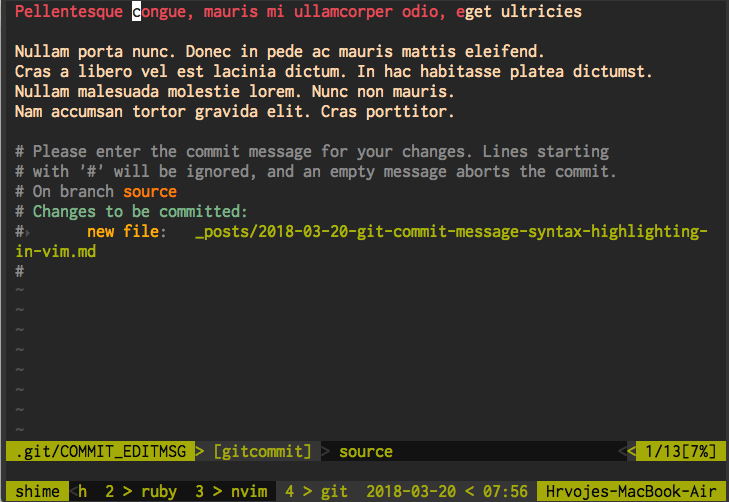

# If you remove a line here THAT COMMIT WILL BE LOST.
EDIT GIT COMMIT MESSAGE HOW TO
# These lines can be re-ordered they are executed from top to bottom. In this snippet, we will show you how to change your most recent commit message, as well as how to change any number of commit messages in the history. git push -force Changing multiple Commit messages If you want to change the multiple commit message instead of the last commit message you need to follow the below steps.

message (or the oneline, if no original merge commit was #. Follow the above two steps Run the git push command followed by the -force flag to change remotely commit message. create a merge commit using the original merge commit's #. # Note that empty commits are commented outĪs you can see all of the last N commits are listed, and you can modify their messages as needed.Pick 975de9e feat(World Peace): started dealing with problems reword 9958258 feat(World Peace): tried to force world peace reword 5c428a2 feat(World Peace): added in some possible solutions pick ca34dd6 feat(World Peace): removed 2 solutions reword fc273f4 feat(World Peace): added the Greta Thunberg solution # Rebase 1c8f5e0.fc273f4 onto ca34dd6 (5 commands) # Commands: # p, pick = use commit # r, reword = use commit, but edit the commit message # e, edit = use commit, but stop for amending # s, squash = use commit, but meld into previous commit # f, fixup = like "squash", but discard this commit's log message # x, exec = run command (the rest of the line) using shell # b, break = stop here (continue rebase later with 'git rebase -continue') # d, drop = remove commit # l, label = label current HEAD with a name # t, reset = reset HEAD to a label # m, merge #. # However, if you remove everything, the rebase will be aborted.

# Rebase d05209d.5e9cdc5 onto d05209d (4 commands) # Commands: # p, pick = use commit # r, reword = use commit, but edit the commit message # e, edit = use commit, but stop for amending # s, squash = use commit, but meld into previous commit # f, fixup = like "squash", but discard this commit log message # x, exec = run command (the rest of the line) using shell # d, drop = remove commit # These lines can be re-ordered they are executed from top to bottom. Pick 788ebf0 Oops, I forgot to add a new file You'll then see a list of commits, similar to this: $ $ git rebase -i HEAD~4 If you make a mistake in a commit message but HAVENT pushed it yet, you can change that commit message with -amend: git commit -amend -m New message. After release, the cleanup will be different according. Here, n is the number of commits you want to inspect and edit. Prior to merging or releasing the mistake, we recommend using git rebase -i to edit the commit history. To start the rebase, you can use the following command: $ git rebase -i HEAD~n Doing this allows you to inspect the last N commits and make changes to them, including picking, squashing, etc. Use Interactive RebaseĪnother option, which is more flexible than the previous solutions described, is to use an interactive rebase. Otherwise, you may need to find another solution to avoid losing any changes made after the commit message you're wanting to change. main angular/CONTRIBUTING.md Go to file alan-agius4 refactor: remove Angular Compatibility Compiler (ngcc) ( 49101) Latest commit 48aa96e on Feb 16 History 49 contributors +30 404 lines (260 sloc) 15. If you can catch the mistake fast enough, then making the change won't be a problem.

This will open the editor pre-populated with your old commit message. We need to do it this way in order to overwrite the remote repository with our own local state.īe aware that by forcing the push, you'll also lose any commits on the local branch that you don't already have in your local branch. If you dont want to rewrite the entire commit message, go for git commit -amend -c HEAD. However, this must be done using the -force flag. Then, you need to push these changes to the remote repository. The first step is to amend the last commit, just like we did in the previous section: $ git commit -amend -m "Added a new file" This is another common case, and is a bit more difficult to fix, not only because we need to modify our own repository, but we also need to modify the remote repository, which could be further ahead than your local branch. Personally, I prefer to do most things on the command line, which you can do by adding an argument and message to the command above: $ git commit -amend -m "Added a new file"ĭoing it this way won't open the editor, but instead it'll just modify the commit message immediately.


 0 kommentar(er)
0 kommentar(er)
